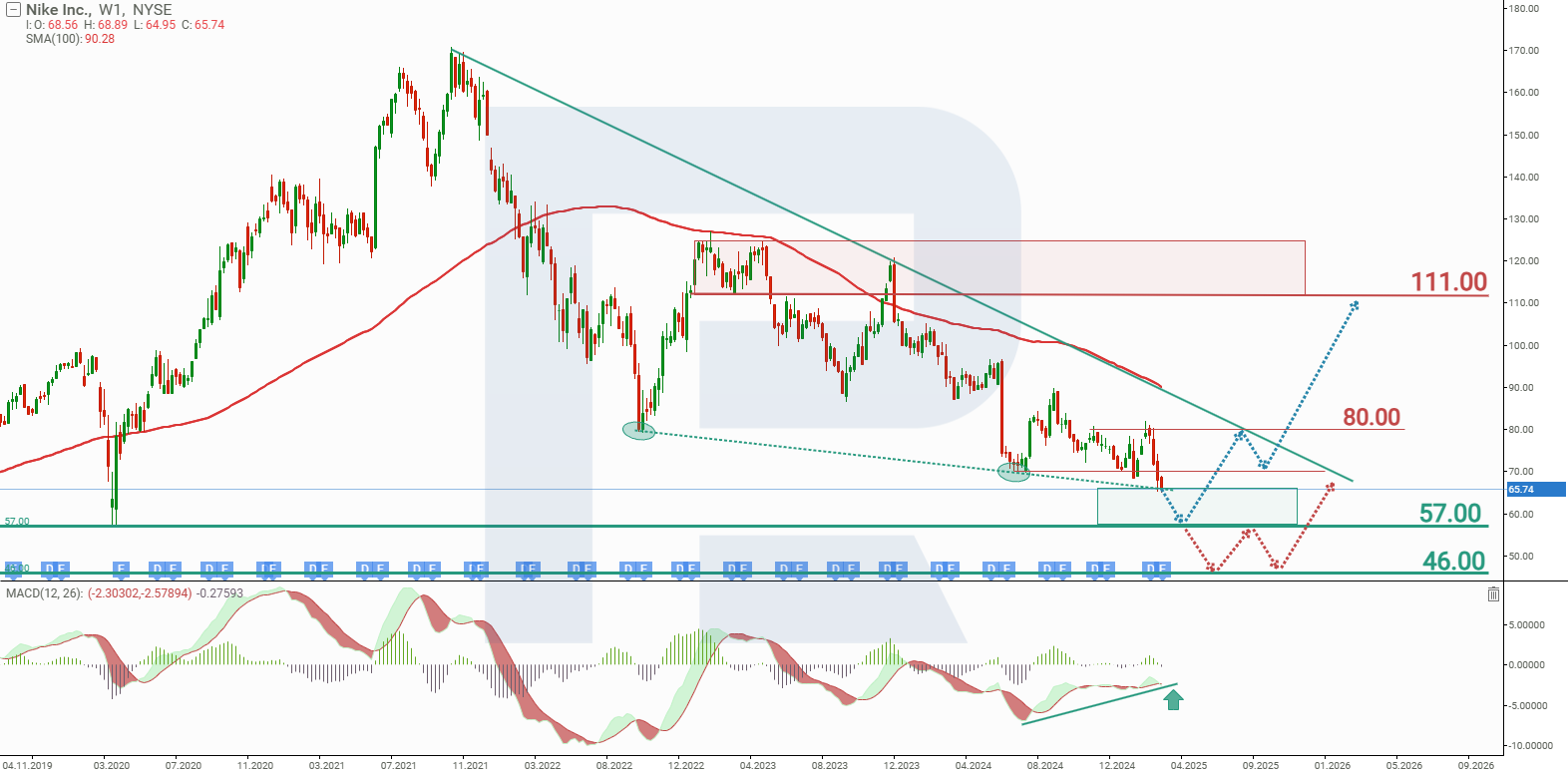Nike in crisis? Investors panic after disastrous report
A decline in revenue and a weak outlook for the next quarter put pressure on Nike stock.
Nike’s Q3 fiscal 2025 report revealed a significant drop in revenue due to sluggish demand in key markets such as China and mounting price pressures, leading to weak guidance for the next quarter. Investors reacted negatively to the report, triggering a sharp decline in Nike’s share price. Market participants question the company’s ability to sustain growth amid intense competition and macroeconomic risks.
This article analyses Nike, Inc., outlines its revenue streams, presents Nike’s Q3 fiscal 2025 performance, and examines expectations for Q4 fiscal 2025. In addition, it provides a technical analysis of NKE, forming the basis for Nike’s stock forecast for 2025.
About Nike, Inc.
Nike, Inc. is a US-based company founded on 25 January 1964 by Phil Knight and Bill Bowerman under the name Blue Ribbon Sports before rebranding as Nike in 1971. The company designs, manufactures, markets, and sells athletic footwear, apparel, accessories, and equipment. Its primary business segment is athletic footwear, which generates the majority of its revenue. Nike produces goods for a variety of sports, including running, basketball, football, tennis, golf, and fitness.
The company was listed on the NYSE on 2 December 1980 under the ticker symbol NKE.
Nike, Inc.’s main revenue streams
Nike’s revenue comes from various sources within its business operations, primarily focusing on key areas such as footwear, apparel, and equipment, as well as brand licensing and digital platforms. Nike’s main revenue streams are outlined below:
- Footwear sales: Nike’s largest source of revenue is footwear, including athletic sneakers, casual shoes, and specialised models for running, basketball, and fitness. In Q3 fiscal 2025, footwear remained the dominant category; however, quarterly data shows a revenue decline in this segment, highlighting challenges linked to excess inventory and competitive pressures
- Apparel sales: this category includes sports and casual apparel such as T-shirts, shorts, tank tops, and outerwear. Apparel complements Nike’s footwear range and is a significant revenue stream, often related to seasonal demand and collaborations with sports companies
- Sports equipment sales: Nike generates revenue from sports equipment such as bags, socks, gloves, and accessories. While smaller than the footwear and apparel segments, this category plays a supporting role in the brand’s ecosystem
- Nike Direct: revenue from direct-to-consumer sales –
including Nike’s website, mobile app, and physical stores –
falls under the Nike Direct segment. This channel prioritises direct sales to consumers, bypassing wholesalers. Digital sales remain a key focus for Nike, with continued investment in e-commerce
Nike, Inc. Q3 FY 2025 report
On 20 March, Nike released its earnings report for the Q3 fiscal year 2025, which ended on 28 February. Below are the key financial figures compared to last year’s corresponding period:
- Revenue: 11.27 billion USD (-9%)
- Net income: 0.79 billion USD (-32%)
- Earnings per share: 0.54 USD (-30%)
- Gross margin: 41.5% (-330 basis points)
Revenue by country:
- North America: 4.86 billion USD (-4%)
- Europe, Middle East, and Africa: 2.81 billion USD (-10%)
- Greater China: 1.73 billion USD (-17%)
- Asia Pacific and Latin America: 1.47 billion USD (-11%)
The company’s management cited a double-digit drop in sales in January and February after a successful festive season in December as the reason for the 9% revenue decline. China saw the most significant slump, with sales falling by 17%. Despite growth in the workout and running apparel categories, Nike noted a decline in the sports style and Jordan brand segments, especially in its classic footwear lines.
Nike’s management forecasts a substantial revenue decline of 13.0-15.0% in the Q4 fiscal year 2025, ending on 31 May 2025, which exceeds analysts’ forecasts of 11.4-12.2%. The outlook reflects efforts to liquidate excess inventories and upgrade outdated product lines amid external factors such as tariffs and economic uncertainty.
CFO Matthew Friend expects gross margin to decrease by 4-5 percentage points due to the active sell-off of old inventories and the introduction of new, innovative models, noting that Q4 fiscal 2025 will be the period with the most significant impact from these measures, after which pressure on revenue and margins will begin to ease in fiscal 2026.
Overall, Nike’s management described the last quarter as a period of progress amid challenges, exceeding income expectations but facing revenue and margin pressure. For the upcoming quarter, they forecast a more substantial decline in sales and margins as part of a strategic business relaunch, with hopes for improvements in the fiscal year 2026.
Expert forecasts for Nike, Inc. stock
- Barchart: 17 out of 33 analysts rated Nike stock as a Strong Buy, one as a Moderate Buy, 13 as a Hold, and two as a Strong Sell. The high price target is 120 USD, while the low one is 49 USD
- MarketBeat: 18 out of 32 specialists assigned a Buy rating to the shares, while 14 gave a Hold recommendation. The high price target is 120 USD, while the low one is 64 USD
- TipRanks: 17 out of 30 respondents gave a Buy rating to the stock, and 13 recommended it as a Hold. The high price target is 120 USD, while the low one is 64 USD
- Stock Analysis: out of 32 experts, eight rated the shares as a Strong Buy, 10 as a Buy, and 14 as a Hold. The high price target is 120 USD, while the low one is 64 USD
Nike, Inc. stock price forecast for 2025
On the weekly timeframe, Nike shares are trading below the 100-day Moving Average, indicating a prevailing downtrend. However, convergence has formed on the MACD indicator, signalling a potential price rise. The nearest support level is at 57 USD. Based on Nike’s stock performance, possible price movements in 2025 are as follows:
The primary forecast for Nike stock suggests that the price could test the 57 USD support level and then climb to the 80 USD resistance level after rebounding. A breakout above this level could drive the share value to 111 USD. This scenario is supported by weak guidance for the next quarter, which could push the stock price down to 57 USD. If the company successfully liquidates its inventories, the situation may improve, boosting the stock price.
The alternative forecast for Nike shares anticipates a breakout below the 57 USD support level, followed by a decline to 46 USD, where investor interest in the company’s stock is expected to rise.
Nike, Inc. stock analysis and forecast for 2025Risks of investing in Nike, Inc. stock
When investing in Nike, it is essential to consider the risks that may negatively impact the company’s income and affect its investors. The main risks are outlined below:
- The impact of tariffs on profit margins: Nike has warned that higher tariffs on imports from China and Mexico could significantly reduce profit margins
- Falling sales and market strategy challenges: Nike reported a 9% decline in sales in the Q3 fiscal year 2025, including a 17% drop in China. The company is implementing the Win Now strategy to strengthen its position in key cities, but its effectiveness remains uncertain
- Competition and loss of market share: Nike faces intense competition from brands such as New Balance and Adidas, which are strengthening their positions, particularly in casual footwear and retro model segments. This poses a threat to Nike’s market share
- Economic instability: factors such as inflation, recession fears, and reduced purchasing power may lead to decreased consumer spending on sportswear and footwear, ultimately impacting Nike’s revenues
Summary
Nike’s Q3 fiscal 2025 results reflect a company in transition and facing serious challenges but laying the foundation for a possible recovery. They point to a period of a conscious rebuilding of the company under new leadership, with the focus on divestiture of excess inventories, upgrading its product line, and strengthening the brand through sports and innovations.
However, the substantial decline in revenue and margin pressure indicates that external factors, such as geopolitical tensions, new tariffs, and changes in consumer sentiment, combined with internal issues like excess inventories and a loss of competitive position in key markets like China, have created a more challenging environment than expected.
To resume growth, Nike needs to strengthen its direct sales segment, which will improve business margins. Expanding collaborations with famous athletes and popular brands will help attract new audiences and increase brand loyalty. Additionally, investing in innovative products will allow Nike to stand out from competitors. A stronger position in key international markets and a flexible pricing policy will also be crucial to the company’s long-term success. By focusing on these strategies, Nike will be able to overcome the current market challenges and ensure sustainable growth in the future.



